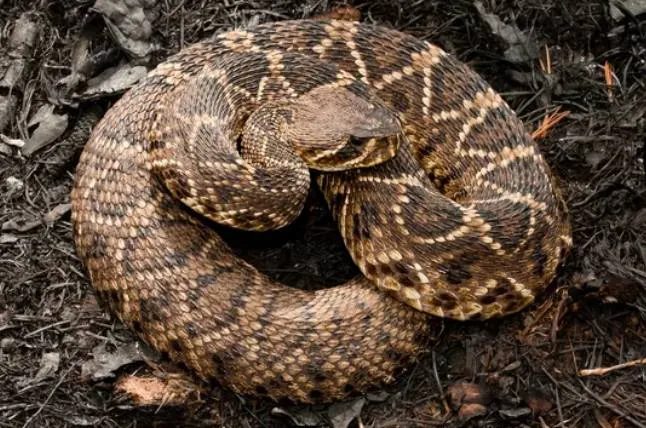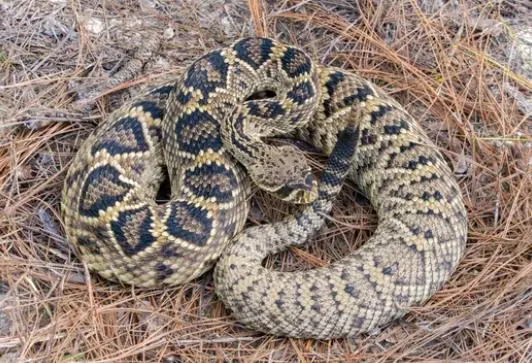The Eastern Diamondback Rattlesnake is a fearsome reptile with striking patterns, powerful venom, and a notable presence in the southeastern United States. Known for its size, strength, and iconic rattle, this species is fascinating to herpetologists and animal lovers alike.

Table of Contents
1. Key Facts and Classification
- Scientific Name: Crotalus adamanteus
- Family: Viperidae
- Length: 2-8 feet (up to 8 feet in rare cases)
- Venomous: Yes, highly venomous
- Lifespan: 10-20 years
- Diet: Carnivorous (preys on small mammals like rats, rabbits, and birds)
2. Appearance and Physical Traits
The Eastern Diamondback Rattlesnake stands out due to its diamond-shaped markings. These diamonds, bordered by yellow, run along the snake’s back, blending seamlessly with its brownish-tan skin for camouflage. It also has a spade-shaped head and elliptical pupils, both adaptations to its predatory lifestyle.
Striking Features:
- Diamond-Shaped Markings: Black or brown diamonds framed by yellow edges.
- Rattle: At the end of its tail, this snake has a signature rattle made from nested scales that warn predators when agitated.
- Size: With lengths up to 8 feet and some individuals weighing as much as 10 pounds, the Eastern Diamondback is both large and intimidating.
3. Habitat and Distribution
Found primarily in the southeastern United States, these snakes inhabit areas such as:
- Longleaf pine forests
- Turkey oak hammocks
- Palmetto stands
- Coastal regions of Louisiana, Mississippi, Alabama, Georgia, the Carolinas, and Florida.
While primarily terrestrial, they are also capable swimmers and occasionally take shelter in rabbit and squirrel burrows.
4. Behavior and Hunting Strategy
Eastern Diamondbacks are both active hunters and ambush predators. When hunting, they remain motionless for days, waiting patiently for prey to come within striking distance. Their prey typically includes small mammals like rabbits, squirrels, and occasionally birds.
Rattlesnake Behavior at a Glance:
- Nocturnal/Crepuscular: Most active during twilight and night hours.
- Defensive Posture: When threatened, they raise their bodies into an S-shape, preparing to strike.
- Rattle Warning: The rattling tail serves as an unmistakable warning to threats.
Despite their fearsome reputation, these snakes prefer to avoid confrontation and will retreat if possible. However, they are more likely to stand their ground compared to other species.
5. Venom and Its Effects
The Eastern Diamondback’s venom is a potent blend of hemotoxins that damage tissues and blood vessels, leading to pain, swelling, and tissue death. However, one in three bites is a “dry bite,” where no venom is injected.
Venom Facts:
- Delivery: Equipped with large hinged fangs, they can inject significant amounts of venom—sometimes up to 400 mg in a single bite.
- Fatality: Without medical treatment, a bite can be fatal, though fatalities are rare with timely intervention.
6. Reproduction and Lifecycle
Eastern Diamondbacks give birth to live young (called neonates), typically between 7-21 babies per litter. The gestation period lasts around 6-7 months. Newborn snakes are fully independent and equipped with venom to defend themselves.
- Birth Season: Late summer to early fall.
- Litter Size: 7-21 babies.
- Age of Independence: Neonates are independent within hours of birth.
7. Conservation Status and Threats
The Eastern Diamondback Rattlesnake is currently listed as Least Concern by the IUCN Red List, though its population is rapidly declining. Habitat destruction, human encounters, and road mortality are significant threats. Its population is estimated to be only 3% of its historic numbers.
- Conservation Efforts: The species is protected in certain states, such as North Carolina, and there are discussions of adding it to the Endangered Species List.
- Human Impact: Eastern Diamondbacks are often killed out of fear or misunderstanding.
8. Fascinating Eastern Diamondback Facts
- Record Size: The largest Eastern Diamondback on record measured 99 inches (8 feet, 3 inches).
- Camouflage: Their patterns and coloration make them nearly invisible in the underbrush, contributing to their effectiveness as predators.
- Rattles: A snake adds a new segment to its rattle each time it sheds its skin, though they can break off over time.

9. How to Stay Safe Around Rattlesnakes
If you’re in areas where Eastern Diamondbacks are native, it’s crucial to understand how to avoid dangerous encounters:
- Stay on Trails: When hiking in snake territory, stick to clear paths.
- Listen for the Rattle: If you hear the distinctive rattle, back away slowly and give the snake space.
- Don’t Disturb: Never attempt to handle or approach a rattlesnake.
By respecting these magnificent creatures, you can safely coexist without putting yourself or the snake at risk.
The Eastern Diamondback Rattlesnake, with its impressive size, venomous bite, and unique rattle, is an essential part of the southeastern U.S. ecosystem. Though feared, this species plays a critical role in controlling rodent populations and maintaining the balance of nature.
By understanding their behavior and habitat, we can learn to appreciate these extraordinary creatures and ensure their survival for generations to come.
- Enchi Ball Python: A Unique and Stunning Morph of Python regius - March 27, 2025
- Emerald Tree Monitor: The Enigmatic Green Guardian of the Rainforest - March 26, 2025
- The Egyptian Cobra (Naja haje): A Fascinating Serpent - March 25, 2025
